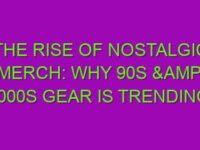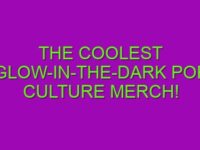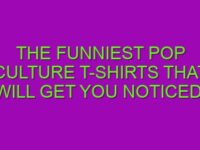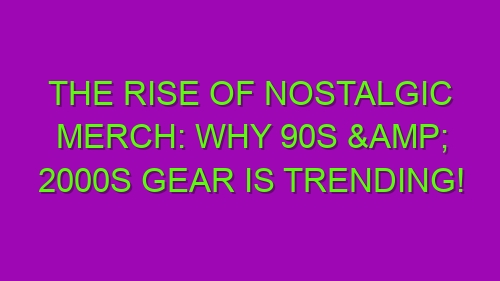-
Table of Contents
The Popularity of Vintage Clothing: Exploring the Resurgence of 90s and 2000s Fashion
The fashion industry is constantly evolving, with trends coming and going faster than ever before. However, in recent years, there has been a noticeable resurgence of 90s and 2000s fashion. From iconic brands like Tommy Hilfiger and FUBU to popular TV shows like Friends and The Fresh Prince of Bel-Air, the nostalgia for this era is undeniable. This article will explore the reasons behind the popularity of vintage clothing and why 90s and 2000s gear is trending.
One of the main reasons for the rise of nostalgic merch is the cyclical nature of fashion. Trends tend to repeat themselves every few decades, and the 90s and 2000s are no exception. As millennials and Gen Zers grow older, they are looking back at their childhood and teenage years with fondness, longing for the simplicity and carefree nature of that time. This desire for nostalgia is reflected in their fashion choices, as they seek to recreate the looks they once loved.
Another factor contributing to the popularity of vintage clothing is the influence of social media. Platforms like Instagram and TikTok have become virtual fashion runways, where influencers and celebrities showcase their unique style. Many of these influencers have embraced the 90s and 2000s aesthetic, inspiring their followers to do the same. As a result, vintage clothing has become a way for individuals to express their individuality and stand out from the crowd.
Furthermore, the sustainability movement has played a significant role in the resurgence of vintage fashion. With growing concerns about the environmental impact of fast fashion, more people are turning to second-hand clothing as a more sustainable alternative. Vintage clothing offers a way to reduce waste and give new life to pre-loved garments. By purchasing vintage pieces, consumers can contribute to a circular economy and reduce their carbon footprint.
In addition to sustainability, the appeal of vintage clothing lies in its uniqueness. Unlike mass-produced fast fashion items, vintage pieces are often one-of-a-kind or limited in quantity. This exclusivity adds to their allure, as individuals strive to create a personal style that sets them apart from the mainstream. Vintage clothing allows them to express their individuality and showcase their creativity through fashion.
Moreover, the rise of online marketplaces and thrift stores has made it easier than ever to find and purchase vintage clothing. With just a few clicks, consumers can browse through a wide selection of 90s and 2000s gear, making it accessible to a larger audience. This convenience has contributed to the growing popularity of vintage fashion, as it eliminates the need to spend hours searching through physical stores.
In conclusion, the resurgence of 90s and 2000s fashion can be attributed to a combination of factors. The cyclical nature of fashion, the influence of social media, the sustainability movement, the appeal of uniqueness, and the accessibility of online marketplaces have all contributed to the popularity of vintage clothing. As the demand for nostalgic merch continues to grow, it is clear that the 90s and 2000s are here to stay in the world of fashion. So, whether you’re a fan of baggy jeans, oversized graphic tees, or chunky sneakers, embrace the nostalgia and rock your favorite 90s or 2000s gear with pride!
Nostalgic Merchandise: How Brands are Capitalizing on the Nostalgia Trend
The Rise of Nostalgic Merch: Why 90s & 2000s Gear is Trending!
Nostalgia is a powerful emotion that can transport us back to a simpler time, evoking feelings of warmth and happiness. In recent years, there has been a surge in the popularity of nostalgic merchandise, particularly from the 90s and 2000s. From clothing to accessories, brands are capitalizing on this trend and tapping into the collective yearning for the past.
One of the main reasons why 90s and 2000s gear is trending is the cyclical nature of fashion. Trends tend to come and go, and what was once considered outdated can suddenly become cool again. This is especially true for millennials and Gen Z, who grew up during this era and now have the purchasing power to indulge in nostalgia. They are drawn to the familiar and find comfort in reliving their youth through fashion.
Another factor contributing to the rise of nostalgic merch is the power of social media. Platforms like Instagram and TikTok have become virtual time machines, allowing users to share and discover content from the past. Influencers and celebrities often showcase their vintage finds, sparking a desire in their followers to own a piece of the past. This has created a ripple effect, with more and more people seeking out nostalgic merchandise to stay on-trend.
Brands have been quick to recognize the potential of this market and have been capitalizing on the nostalgia trend. They are reissuing popular designs from the 90s and 2000s, tapping into their archives to bring back iconic pieces. This not only appeals to those who lived through that era but also to younger generations who are drawn to the retro aesthetic. By reimagining and re-releasing these items, brands are able to tap into a sense of nostalgia while still offering something new and exciting.
Collaborations have also played a significant role in the resurgence of nostalgic merch. Brands have been teaming up with celebrities and influencers who have a strong connection to the 90s and 2000s. These collaborations often result in limited-edition collections that sell out within minutes. By leveraging the star power and nostalgia factor, brands are able to create a sense of urgency and exclusivity, driving up demand and generating buzz.
Furthermore, the rise of sustainable fashion has also contributed to the popularity of nostalgic merch. As consumers become more conscious of their environmental impact, they are turning to second-hand and vintage clothing as a more sustainable option. Thrift stores and online marketplaces have seen a surge in demand for 90s and 2000s gear, as people seek out unique and pre-loved items. This shift towards sustainability has further fueled the nostalgia trend, as vintage clothing embodies a sense of history and authenticity.
In conclusion, the rise of nostalgic merch from the 90s and 2000s can be attributed to various factors. The cyclical nature of fashion, the power of social media, and the influence of celebrities and influencers have all played a role in driving this trend. Additionally, the rise of sustainable fashion has further fueled the demand for vintage clothing. As brands continue to tap into the nostalgia market, we can expect to see more iconic designs from the past making a comeback, allowing us to relive our favorite memories and embrace the nostalgia of yesteryears.
The Influence of Social Media: How Platforms like Instagram are Driving the Demand for Nostalgic Merch
The Influence of Social Media: How Platforms like Instagram are Driving the Demand for Nostalgic Merch
In today’s digital age, social media platforms have become powerful tools for shaping trends and influencing consumer behavior. One particular trend that has gained significant traction in recent years is the resurgence of nostalgic merchandise from the 90s and 2000s. From clothing to accessories, these throwback items have become highly sought after by millennials and Gen Z, and social media, particularly Instagram, has played a pivotal role in driving the demand for such merchandise.
Instagram, with its visually appealing interface and emphasis on aesthetics, has become a hub for nostalgia-driven content. Influencers and celebrities alike have taken to the platform to showcase their love for all things retro, often sporting vintage clothing and accessories from the 90s and 2000s. This exposure has not only sparked a sense of nostalgia among users but has also created a desire to own similar items.
The power of Instagram lies in its ability to create a sense of community and connection. Users can easily discover and follow accounts dedicated to nostalgic merchandise, where they can engage with like-minded individuals who share their love for the past. This sense of belonging fuels the desire to own nostalgic merch, as users seek to express their identity and be part of a larger cultural movement.
Furthermore, Instagram’s algorithm-driven feed ensures that users are constantly exposed to content that aligns with their interests. This means that users who engage with nostalgic content are more likely to see similar posts in their feed, further reinforcing their desire for nostalgic merchandise. The platform’s Explore page also plays a significant role in driving the demand for such items, as it suggests content based on users’ browsing history and engagement patterns.
Another factor contributing to the rise of nostalgic merch on Instagram is the rise of influencer marketing. Brands have recognized the power of influencers in shaping consumer behavior and have partnered with them to promote their nostalgic merchandise. Influencers, with their large following and ability to connect with their audience, have become trusted sources of recommendations. When influencers showcase their love for a particular brand or item, their followers are more likely to be influenced and make a purchase.
Moreover, Instagram’s shopping features have made it easier than ever for users to purchase nostalgic merchandise. Brands can tag their products in posts, allowing users to click on the tags and be redirected to the brand’s website for a seamless shopping experience. This convenience has undoubtedly contributed to the increased demand for nostalgic merch, as users can now easily find and purchase the items they desire.
In conclusion, social media platforms like Instagram have played a significant role in driving the demand for nostalgic merchandise from the 90s and 2000s. Through its visually appealing interface, sense of community, and algorithm-driven feed, Instagram has created a space where users can connect with like-minded individuals and discover nostalgic content. Influencers and brands have capitalized on this trend, further fueling the desire for nostalgic merch. With Instagram’s shopping features, users can now easily purchase these items, making the trend more accessible than ever before. As social media continues to evolve, it is likely that the demand for nostalgic merchandise will continue to grow, driven by the influence of platforms like Instagram.




















0 Comments